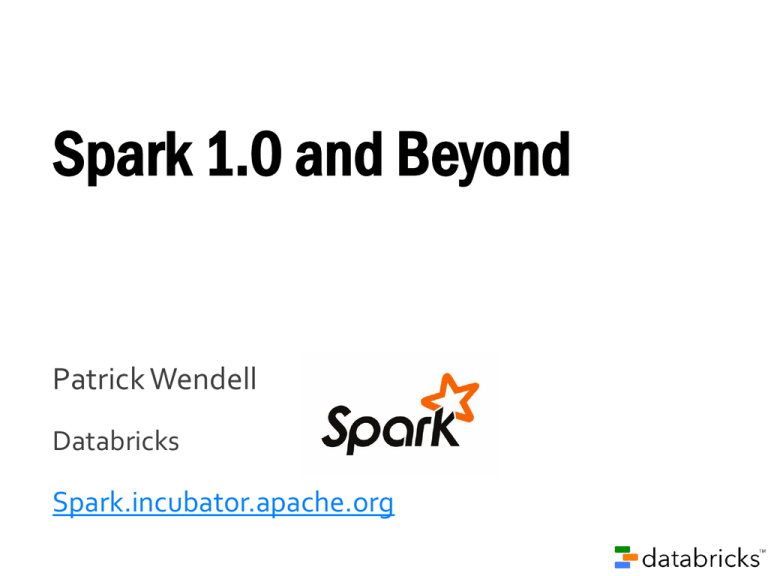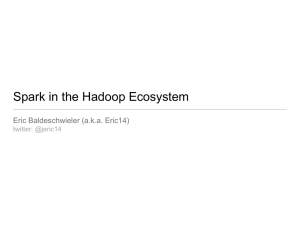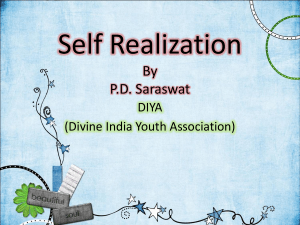Spark 1.0 Meetup.ppt 457kB, uploaded 4/23/14 by Scott W. Public
advertisement

Spark 1.0 and Beyond
Patrick Wendell
Databricks
Spark.incubator.apache.org
About me
Committer and PMC member of Apache Spark
“Former” PhD student at Berkeley
Release manager for Spark 1.0
Background in networking and distributed systems
Today’s Talk
Spark background
About the Spark release process
The Spark 1.0 release
Looking forward to Spark 1.1
What is Spark?
Fast and Expressive Cluster Computing
Engine Compatible with Apache Hadoop
Efficient
Usable
General execution
graphs
Rich APIs in Java, Scala,
Python
In-memory storage
Interactive shell
30-Day Commit Activity
250
200
45000
16000
40000
14000
35000
12000
30000
150
10000
25000
8000
20000
100
6000
15000
4000
10000
50
0
5000
2000
0
0
Patches
Lines Removed
Lines Added
MapReduce
Storm
MapReduce
Storm
MapReduce
Storm
Yarn
Spark
Yarn
Spark
Yarn
Spark
Spark Philosophy
Make life easy and productive for data scientists
Well documented, expressive API’s
Powerful domain specific libraries
Easy integration with storage systems
… and caching to avoid data movement
Predictable releases, stable API’s
Spark Release Process
Quarterly release cycle (3 months)
2 months of general development
1 month of polishing, QA and fixes
Spark 1.0 Feb 1 April 8th, April 8th+
Spark 1.1 May 1 July 8th, July 8th+
Spark 1.0:
By the numbers
- 3 months of development
- 639 patches
- 200+ JIRA issues
- 100+ contributors
API Stability in 1.X
API’s are stable for all non-alpha projects
Spark 1.1, 1.2, … will be compatible
@DeveloperApi
Internal API that is unstable
@Experimental
User-facing API that might stabilize later
Today’s Talk
About the Spark release process
The Spark 1.0 release
Looking forward to Spark 1.1
Spark 1.0 Features
Core engine improvements
Spark streaming
MLLib
Spark SQL
Spark Core
History server for Spark UI
Integration with YARN security model
Unified job submission tool
Java 8 support
Internal engine improvements
History Server
Configure with :
spark.eventLog.enabled=true
spark.eventLog.dir=hdfs://XX
In Spark Standalone, history server is embedded in
the master.
In YARN/Mesos, run history server as a daemon.
Job Submission Tool
Apps don’t need to hard-code master:
conf = new SparkConf().setAppName(“My App”)
sc = new SparkContext(conf)
./bin/spark-submit <app-jar> \
--class my.main.Class
--name myAppName
--master local[4]
--master spark://some-cluster
Java 8 Support
RDD operations can use lambda syntax
class Split extends FlatMapFunction<String, String> {
public Iterable<String> call(String s) {
return Arrays.asList(s.split(" "));
}
);
JavaRDD<String> words = lines.flatMap(new Split());
Old
JavaRDD<String> words = lines
.flatMap(s -> Arrays.asList(s.split(" ")));
New
Java 8 Support
NOTE: Minor API changes
(a) If you are extending Function classes, use
implements rather than extends.
(b) Return-type sensitive functions
mapToPair
mapToDouble
Python API Coverage
rdd operators
intersection(), take(), top(), topOrdered()
meta-data
name(), id(), getStorageLevel()
runtime configuration
setJobGroup(), setLocalProperty()
Integration with YARN
Security
Supports Kerberos authentication in YARN
environments:
spark.authenticate = true
ACL support for user interfaces:
spark.ui.acls.enable = true
spark.ui.view.acls = patrick, matei
Engine Improvements
Job cancellation directly from UI
Garbage collection of shuffle and RDD data
Documentation
Unified Scaladocs across modules
Expanded MLLib guide
Deployment and configuration specifics
Expanded API documentation
SchemaRDD’s
Spark
SQL
DStream’s:
Streams of RDD’s
RDD-Based
Matrices
Spark
Streaming
MLLib
real-time
machine
learning
RDDs, Transformations, and Actions
Spark
Spark SQL
Turning an RDD into a Relation
// Define the schema using a case class.
case class Person(name: String, age: Int)
// Create an RDD of Person objects, register it as a table.
val people =
sc.textFile("examples/src/main/resources/people.txt")
.map(_.split(",")
.map(p => Person(p(0), p(1).trim.toInt))
people.registerAsTable("people")
Querying using SQL
// SQL statements can be run directly on RDD’s
val teenagers =
sql("SELECT name FROM people
WHERE age >= 13 AND age <= 19")
// The results of SQL queries are SchemaRDDs and support
// normal RDD operations.
val nameList = teenagers.map(t => "Name: " + t(0)).collect()
// Language integrated queries (ala LINQ)
val teenagers =
people.where('age >= 10).where('age <= 19).select('name)
Import and Export
// Save SchemaRDD’s directly to parquet
people.saveAsParquetFile("people.parquet")
// Load data stored in Hive
val hiveContext =
new org.apache.spark.sql.hive.HiveContext(sc)
import hiveContext._
// Queries can be expressed in HiveQL.
hql("FROM src SELECT key, value")
In Memory Columnar
Storage
Spark SQL can cache tables using an in-memory
columnar format:
- Scan only required columns
- Fewer allocated objects (less GC)
- Automatically selects best compression
Spark Streaming
Web UI for streaming
Graceful shutdown
User-defined input streams
Support for creating in Java
Refactored API
MLlib
Sparse vector support
Decision trees
Linear algebra
SVD and PCA
Evaluation support
3 contributors in the last 6 months
MLlib
Note: Minor API change
val data = sc.textFile("data/kmeans_data.txt")
val parsedData = data.map(
s => s.split(‘\t').map(_.toDouble).toArray)
val clusters = KMeans.train(parsedData, 4, 100)
val data = sc.textFile("data/kmeans_data.txt")
val parsedData = data.map(
s => Vectors.dense(s.split(' ').map(_.toDouble)))
val clusters = KMeans.train(parsedData, 4, 100)
1.1 and Beyond
Data import/export leveraging catalyst
HBase, Cassandra, etc
Shark-on-catalyst
Performance optimizations
External shuffle
Pluggable storage strategies
Streaming: Reliable input from Flume and Kafka
Unifying Experience
SchemaRDD represents a consistent integration point
for data sources
spark-submit abstracts the environmental details
(YARN, hosted cluster, etc).
API stability across versions of Spark
Conclusion
Visit spark.apache.org for videos, tutorials, and
hands-on exercises.
Help us test a release candidate!
Spark Summit on June 30th
spark-summit.org
Meetup group
meetup.com/spark-users




